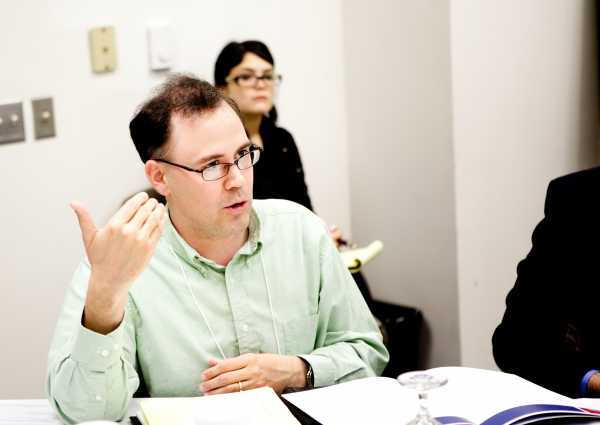
Professor Seipp teaches a senior-level research seminar on the Holocaust for history majors. For faculty members whose primary interests fall outside of the United States, he says, “Identifying primary sources in English for seminar students can be an insurmountable challenge. Since 24,823 of the testimonies are in English, the VHA offers a potential solution for those teaching classes in a range of areas.”
Each student is responsible for identifying a survivor testimony in the VHA and to write a 15-page paper that contextualizes that survivor’s story, with particular emphasis on his or her encounter with the machinery of destruction in German-occupied Europe. During the course, students are responsible for a considerable amount of secondary-source reading, an oral presentation, and a transcript of 20 minutes of testimony of their choosing. Professor Seipp taught the seminar, using the VHA in the classroom for the first time and offers three challenges that could be helpful to others planning to teach a similar course.
- First, students come to class with a range of images and ideas about the Holocaust but generally with little specific background on the subject. Professor Seipp affirms that “if the VHA is to be used as a teaching and research tool for historians, it has to be balanced with a firm grounding in the specific circumstances of the Final Solution.” This means teaching a course on the Holocaust while trying to teach the practicalities of historical writing. The exercise that worked well for him was to have students provide maps that show the physical location and route of their survivor throughout the testimony. It helped to orient the students and to remind them that these survivors came from a specific place and time.
- Second, he notes, “There is the problem of teaching oral history. Turning students loose on testimonies, without providing any kind of orientation to the field of oral history or an understanding of the challenges of working with oral sources, invites problem.” In designing the syllabus, developing a course that one could teach the craft of research and writing—with enough background on the Holocaust so that students could approach the subject on its own terms and a primer on oral history could be a daunting task and difficult to accomplish. Seipp admits that this approach did not work. Instead, he recommends spending more time helping students to understand the way stories are told and different ways to approach these testimonies, which aids them in becoming critical thinkers and writers.
- Third, Seipp asserts, “closely related to the second problem is a generational dilemma. Many traditional college students today, unlike most of their instructors, never had a living relative with adult memories of the Second World War. The war, and with it the Holocaust, is passing from living memory very quickly.” Therefore, he cautions, when students are asked to watch and think critically about these testimonies, what we really are asking them to do is to evaluate the words of people who are older than their grandparents. This sets up a critical barrier that prevents some students from being able to evaluate these testimonies as historical documents. On several occasions, students discover that their survivor recalled the liberation of their camp on a date that contradicted what the student found in the
secondary literature. Therefore students have to be reassured that pointing out inconsistencies in oral history testimony is not the same as questioning the veracity and honesty of an elderly survivor.
“After a review of the final papers and positive response and evaluations from the student, teaching the course with the use of the VHA for the first time seemed successful, with several challenges to overcome, some of which were anticipated.” The technological obstacles were less daunting than initially imagined. Due to having tech-savvy students and outstanding support from reference staff at the Texas A&M University Libraries, the technical nightmare once feared before the course did not come to pass. Students did complain, however, that they could not access the VHA from home due to bandwidth issues.
Professor Seipp offers two recommendations when designing or teaching such a course with the VHA, which helps bring awareness of the VHA among students, faculty, researchers and other library staff within the institution. First, develop a good relationship with the support personnel at your institution. While the VHA is indexed and searchable, students need solid preparation to make the process work effectively. Second, courses on the Holocaust are popular with students, and this is a great opportunity to reach out to stakeholders across the institution. Professor Seipp has been fortunate to receive three curriculumdevelopment grants from different sources within the university, which have allowed him to buy course materials and to support a number of visits from guest speakers.